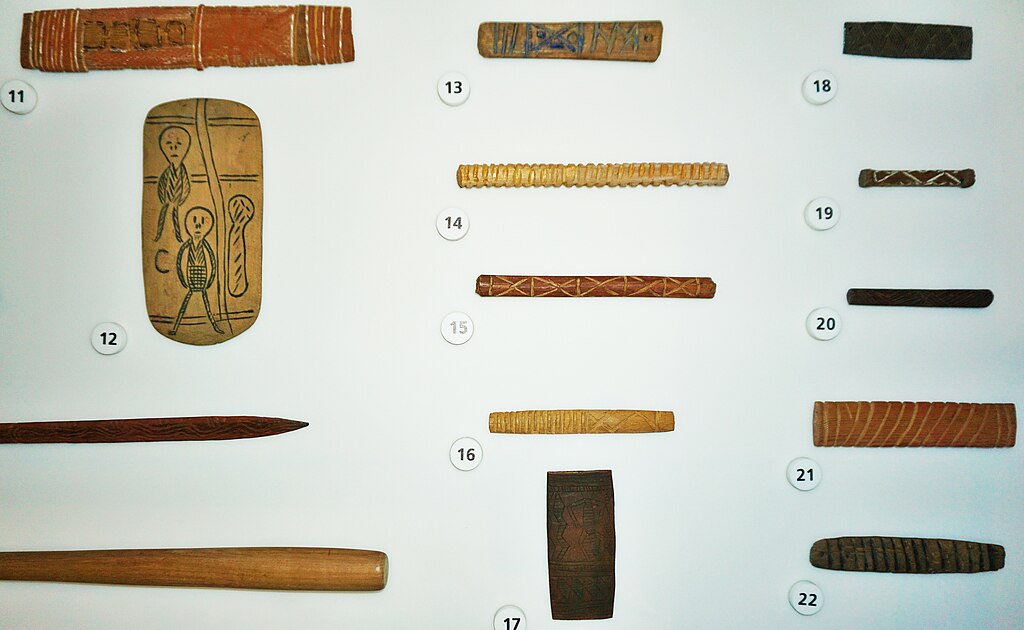
These Australian Aboriginal Message Sticks are a form of communication traditionally used by Indigenous Australians. It is usually a solid piece of wood, of varying length, etched with angular lines and dots.
The patterns were used as a general reminder of the message.
Traditionally, message sticks were passed between different clans and language groups to send messages. They were often used to invite neighboring groups to corroborees, set-fights, and games.
An Australian anthropologist wrote of the Wurundjeri people of the Melbourne area:
“The oldest man having made a message stick hands it to the old man nearest to him,
who inspects it and, if necessary, adds further marks ….
Finally, the stick having passed from one to the other of the old men present is handed to the messenger…”
Message Sticks are often commonly called letters by Aboriginal people. They were transmitted by messengers, who could travel hundreds of kilometers to deliver them.
The carrier of the message stick was granted safe passage across other aboriginal nation’s lands.

Australian Aboriginals
Australian Aboriginals refer to the people who are members of the several hundred Indigenous peoples of Australia. The category “Aboriginal Australia” was coined by the British after they began colonizing Australia in 1788.
The term was used to refer collectively to all the people they found already inhabiting the continent. Later the term described the descendants of any of those people.
The Constitution of Australia, in its original form as of 1901, referred to Aboriginals twice, but without definition.
Before the British colonization of Australia, there existed several hundred groupings of Indigenous peoples of Australia with their own defined territory.
Within each region or country, people lived in clan groups: extended families defined by various forms of Australian Aboriginal kinship.
Inter-clan contact was frequent, as was inter-country communication, but there were strict protocols around this contact.
The Australian Aboriginal languages, before colonization, consisting of over 300 languages belonging to an estimated twenty-eight language families.
Today, the most significant single language group of Aboriginal people live in the area around Uluru (Ayers Rock) and south into South Australia. T
he second-largest Aboriginal distinct community lives in and around Alice Springs in the Northern Territory.
Aboriginal Message Stick
- Subject: Aboriginal Message Stick
- Material: Wood
- Dates: 19th & 20th Century
- Museum: Australian Museum
Australian Aboriginal Message Stick
The Message Stick
Virtual Tour of Aboriginal Artifacts and Stories
- Australian Aboriginal Sayings and Quotes
- Australian Aboriginal Rock Art – Bradshaw Rock Paintings
- Indigenous Australian Rock Art – Wandjina Style
- Australian Aboriginal Bark Paintings
- Coolamons and Aboriginal Carrying Vessels
- Aboriginal Shields
- Australian Aboriginal Shields
- Woureddy, an Aboriginal Chief of Van Diemen’s Land
- Trucaninny, wife of Woureddy
- Aboriginal Message Stick
- Platypus Nest
- Thylacine Skeleton (Tasmanian Tiger)
- Mummified Thylacine Head
- Aboriginal King Plate of Billie Hippie
- Australian Aboriginal Sayings and Quotes
- Bedgi-Bedgi
- Australian Native Police Uniform
- A Book of Drawings by Tommy McRae
- “View taken from the spot – Bateman’s Hill” by George Alexander Gilbert
Australian Aboriginal Message Stick
~~~
“We are all visitors to this time, this place. We are just passing through.
Our purpose here is to observe, to learn, to grow, to love… and then we return home.”
– Australian Aboriginal saying
~~~
Photo Credit: GM
Popular this Week








 Sponsor your Favorite Page
Sponsor your Favorite Page SEARCH Search for: Search Follow UsJoin – The JOM Membership Program
Sponsor a Masterpiece with YOUR NAME CHOICE for $5
Share this:
- Tweet
